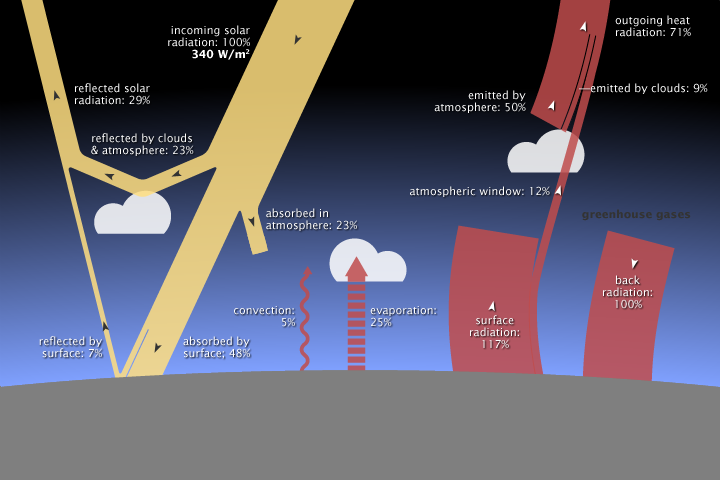

Just as the incoming and outgoing energy at the Earth’s surface must balance, the flow of energy into the atmosphere must be balanced by an equal flow of energy out of the atmosphere and back to space. Satellite measurements indicate that the atmosphere radiates thermal infrared energy equivalent to 59 percent of the incoming solar energy. If the atmosphere is radiating this much, it must be absorbing that much. Where does that energy come from?
Clouds, aerosols, water vapor, and ozone directly absorb 23 percent of incoming solar energy. Evaporation and convection transfer 25 and 5 percent of incoming solar energy from the surface to the atmosphere. These three processes transfer the equivalent of 53 percent of the incoming solar energy to the atmosphere. If total inflow of energy must match the outgoing thermal infrared observed at the top of the atmosphere, where does the remaining fraction (about 5-6 percent) come from? The remaining energy comes from the Earth’s surface.
Just as the major atmospheric gases (oxygen and nitrogen) are transparent to incoming sunlight, they are also transparent to outgoing thermal infrared. However, water vapor, carbon dioxide, methane, and other trace gases are opaque to many wavelengths of thermal infrared energy. Remember that the surface radiates the net equivalent of 17 percent of incoming solar energy as thermal infrared. However, the amount that directly escapes to space is only about 12 percent of incoming solar energy. The remaining fraction—a net 5-6 percent of incoming solar energy—is transferred to the atmosphere when greenhouse gas molecules absorb thermal infrared energy radiated by the surface.

The atmosphere radiates the equivalent of 59% of incoming sunlight back to space as thermal infrared energy, or heat. Where does the atmosphere get its energy? The atmosphere directly absorbs about 23% of incoming sunlight, and the remaining energy is transferred from the Earth’s surface by evaporation (25%), convection (5%), and thermal infrared radiation (a net of 5-6%). The remaining thermal infrared energy from the surface (12%) passes through the atmosphere and escapes to space. (NASA illustration by Robert Simmon. Astronaut photograph ISS017-E-13859.)
When greenhouse gas molecules absorb thermal infrared energy, their temperature rises. Like coals from a fire that are warm but not glowing, greenhouse gases then radiate an increased amount of thermal infrared energy in all directions. Heat radiated upward continues to encounter greenhouse gas molecules; those molecules absorb the heat, their temperature rises, and the amount of heat they radiate increases. At an altitude of roughly 5-6 kilometers, the concentration of greenhouse gases in the overlying atmosphere is so small that heat can radiate freely to space.
Because greenhouse gas molecules radiate heat in all directions, some of it spreads downward and ultimately comes back into contact with the Earth’s surface, where it is absorbed. The temperature of the surface becomes warmer than it would be if it were heated only by direct solar heating. This supplemental heating of the Earth’s surface by the atmosphere is the natural greenhouse effect.
The natural greenhouse effect raises the Earth’s surface temperature to about 15 degrees Celsius on average—more than 30 degrees warmer than it would be if it didn’t have an atmosphere. The amount of heat radiated from the atmosphere to the surface (sometimes called “back radiation”) is equivalent to 100 percent of the incoming solar energy. The Earth’s surface responds to the “extra” (on top of direct solar heating) energy by raising its temperature.

On average, 340 watts per square meter of solar energy arrives at the top of the atmosphere. Earth returns an equal amount of energy back to space by reflecting some incoming light and by radiating heat (thermal infrared energy). Most solar energy is absorbed at the surface, while most heat is radiated back to space by the atmosphere. Earth's average surface temperature is maintained by two large, opposing energy fluxes between the atmosphere and the ground (right)—the greenhouse effect. NASA illustration by Robert Simmon, adapted from Trenberth et al. 2009, using CERES flux estimates provided by Norman Loeb.)
Why doesn’t the natural greenhouse effect cause a runaway increase in surface temperature? Remember that the amount of energy a surface radiates always increases faster than its temperature rises—outgoing energy increases with the fourth power of temperature. As solar heating and “back radiation” from the atmosphere raise the surface temperature, the surface simultaneously releases an increasing amount of heat—equivalent to about 117 percent of incoming solar energy. The net upward heat flow, then, is equivalent to 17 percent of incoming sunlight (117 percent up minus 100 percent down).
Some of the heat escapes directly to space, and the rest is transferred to higher and higher levels of the atmosphere, until the energy leaving the top of the atmosphere matches the amount of incoming solar energy. Because the maximum possible amount of incoming sunlight is fixed by the solar constant (which depends only on Earth’s distance from the Sun and very small variations during the solar cycle), the natural greenhouse effect does not cause a runaway increase in surface temperature on Earth.